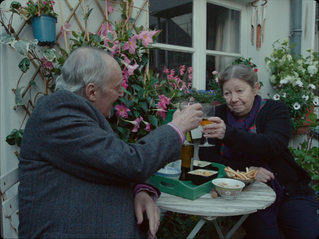Duality in Vortex
- George Turner
- Nov 20, 2022
- 4 min read

A cosy Parisian apartment, both symbolically and literally a time capsule of two lifelong lovers, is revealed to be as mortal – as temporary – in its existentiality as its elderly inhabitants.
Gaspar Noé’s seventh feature, his most recent, will be instantly recognised as in many ways departing from the director’s former oeuvres. A lugubrious, sluggish, and relatively quiet film, Vortex distinguishes itself by sparing its audience from the vehement and vociferous portrayal of extreme violence, graphic sex, or drug usage that frequented the screen in earlier works. It remains, however, no less confrontational in the unforgiving telling of its tragic story, which employs powerful performance and effective formal devices to establish overlapping matrices of dialectical relationships – both within and beyond the diegesis.
The first of such relationships is that of the married couple, portrayed masterfully by Dario Argento and Françoise Lebrun. The father is an academic spending his later years attempting to establish a revolutionary psychoanalytic theory regarding films-as-dreams. His spouse is a retired psychiatrist who is gradually falling victim to dementia.
The pair live in a quaint Parisian apartment, brimming with incalculable assortments of books, papers, binders, receipts, and sentimental decorative keepsakes. As the mother’s condition worsens, her symptoms escalate and her husband and son (with his own son and an array of substance abuse problems) are made to meddle with her mulishness as she episodically becomes afraid of her husband, vacantly strays from the flat, or disposes of her husband’s work down the toilet. The couple refuse their son’s encouragement to move out of their flat, insisting they are fine to continue living there. Upon their passing, the flat is emptied of their myriad belongings.
The cogent performance of its two leads is supplemented by the use of various formal devices, most notably a literal screen divider. Only in a short prologue do we see the couple share the frame together. Shortly thereafter, during the mother’s first onscreen ‘episode’ of confusion while she lies beside the husband, the frame splits, placing each character on either side of the screen. For the remaining duration of the film, the pair will not be completely together in the frame again.

The diptych visualisation renders each disparate experience of the protagonists far richer than if they were viewed in isolation. Opening scenes of the mother’s thoughtless wandering around a Parisian shop, or the father’s solitary studying, are given new emotional depth when they are viewed literally adjacent to one another. No longer individuated events, they are instead a contrasting whole that induces (among other things) a gruelling fear for the mother’s safety, and anxiety regarding the father’s ignorance of her condition. This visual duality offers a uniquely continuous collision of two images, yielding a correspondingly unique output of emotional and artistic significance à la Kuleshov.
Occasionally the two images will feature overlapping components, such as one reaching across a table to console another, or a character’s head partially crossing over to the other side of the screen. The result, evocative of a magic-eye illusion, offers a solemn formal narration: these partners are now splintered fragments of a previous romantic whole, sharing only sparing lucid moments together.

The diptych tool is further supplemented by documentary-esque aesthetics, with handheld camerawork and extended take lengths that sometimes last for over ten minutes. Narratologically, these formal elements afford greater access to each protagonist’s events in the plot – a unique alignment which, in turn, produces a unique moral ambiguity regarding our allegiance to these characters.

Firstly, we are progressively morally distanced from the mother by virtue of her comprehension of daily life being almost entirely divorced from our own, leading her to make irresponsible, if innocent, decisions. The formal aesthetics of Vortex underscore this disparity by maintaining eye-level handheld cinematography and often unbroken takes of her pacing the flat or the streets of Paris, while also reminding the audience via the split screen of how underqualified her husband is in caring for her. In doing so the film observes (and thus encourages the audience to observe) her in a way at once both intimate yet distant, forcing on the viewer a sympathetic yet helpless moral stance.
The audience is likewise alienated from the father as a result of extended exposure (again, afforded by the split-screen and long-take documentary aesthetic) to his naivety about his suitability to live in the apartment; his frequently unsympathetic retaliation to the mother’s declining mental state; and his maintaining of a long-term romantic affair. We are thus granted access to more information about the events of each person than their respective partner, but in doing so our allegiance to them both is stifled. A muddy, melancholic ambivalence results.
A final, equally interesting duo in the film is the couple as a unit and their apartment. In employing the aforementioned formal devices – forcing to the forefront the obviously comforting yet confounding effect of the labyrinthine apartment on the mother, and its symbol as a marker of adequacy for the father – Noé establishes an additional implicit duality that is experientially human: the duality between the living and the spaces they live in.

The film’s closing moments, depicting the gradual emptying of the apartment, juxtaposes earlier scenes, shifting from the claustrophobic concentration on the couple to the apartment’s importance throughout their lives. The inhabited spaces in the apartment (as markers of the chronology of their inhabitants’ lives) themselves become nonhuman characters that have a human-like fragility and impermanence. The ontological role of these spaces as inhabited environments remains only so for as long as their two cohabitants require them as such.
At its most sentimental, Vortex establishes a further, implicit dichotomy between the frenetic and cruel reality of domestic life (and our comprehension of its finality), and the banal spaces that bear witness to it – evincing the human imprint on them, and thus serving as reminders of our existential impermanence.









Comments